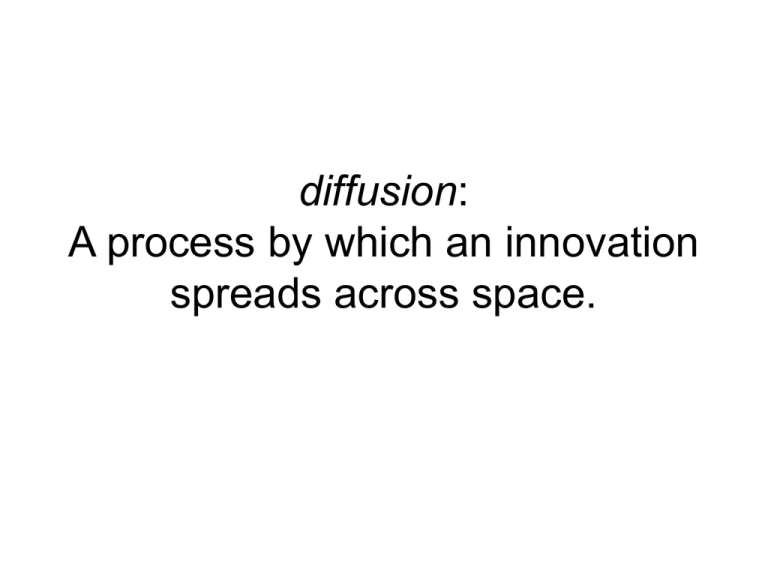diffusion - Cloudfront.net
advertisement

diffusion: A process by which an innovation spreads across space. innovation: the phenomenon that diffuses. (This could be an idea, a disease, an invention, a new style of fashion or music, a language, a word, a product, a religion, a food, news, a sport...almost anything!) hearth (aka node): the place from which an innovation originates and then diffuses. Hearths require a culture group that has 1) the willingness, 2) the technical ability, and 3) the financial resources to accept and nurture the innovation. There are three cultural and economic hearths in the world today: N. America, Europe, and Japan. New York, London, and Tokyo are known as economic command centers because economic commands are issued from these cities. periphery: the place to which an innovation spreads. In general Asia, Africa, and Latin America are peripheral in this sense. independent invention (aka parallel invention): when there are two or more hearths without contact with each other from which an innovation originates diffusion barrier: any factor that slows down or blocks diffusion. The most basic barrier to diffusion is distance. time-distance decay (aka friction of distance): the idea that the farther away a place is from a hearth and the longer it takes an innovation to reach its potential adopters, the less likely the innovation will be adopted. For some (but not all) phenomena, technology is making distance less of a barrier to diffusion. This is called: Space-Time Compression: the reduction in the time it takes for an innovation to diffuse due to technology. Space-Time compression Distances seem less remote. We know what is going on elsewhere sooner. Space-Time compression has accelerated rapidly in recent years due to affordable and widespread air travel, internet, cell phones, etc. Other types of diffusion barriers: physical barriers: oceans, rivers, mountain, deserts, walls, political borders. cultural barriers (most important): language, sexual mores, dietary restrictions, religious taboos, long standing traditions. economic barriers: Adopters cannot afford innovation or see no economic benefit in it. S-shape adoption curve: a graph showing the rate at which an innovation is typically adopted in a population. Laggards Majority Innovators First stage: few adopters because innovation is not widely known and because most of population is risk averse (why not wait?) Second stage: number of adopters grows exponentially as word spreads and perceived risk and price (if applicable) decrease. The majority of all eventual adopters adopt in this stage. Third stage: rate of adoption tapers off as there are fewer people susceptible to adoption and novelty wears off. Types of Diffusion Relocation Contagious Expansion Hierarchical Stimulus Types of Diffusion • Relocation- The spread of an idea through the movement of people from one place to another. • Expansion- when an innovation or idea develops in a hearth and remains strong there while also spreading outward through a snowball effect. – Contagious- a form of expansion diffusion characterized by a rapid widespread diffusion of a characteristic throughout a population through direct person to person contact, analogous to the spread of a disease – Hierarchal- a form of expansion diffusion characterized by the spread of an idea from powerful persons (political or business leaders, social elites, or other important persons) or from places of power (usually large cities) to other persons or places, jumping over intervening areas. – Stimulus- a form of expansion diffusion in which an innovation is not adopted in its entirety but nevertheless stimulates some experimentation) or imitative behavior in the new community. Expansion vs. Relocation Diffusion H Expansion Diffusion Innovation stays strong at hearth while expanding elsewhere. H Relocation Diffusion Innovation is carried away from hearth most often via migration and may die out at hearth. The wearing of turquoise jewelry has waves of popularity, but remains strongest at its hearth in New Mexico and Arizona. Is this an example expansion or relocation diffusion? What type of diffusion brought Christianity to North America? Contagious vs. Hierarchical Diffusion (Both forms of expansion diffusion because the innovation can spread while people stay in place.) Contagious Diffusion Hierarchical Diffusion The innovation spreads outward through direct person to person contact. No jumping. The innovation spreads from one power node to another jumping over intervening areas. Classic wave pattern of contagious diffusion. (Left: spread of agriculture from Middle East into Europe. Right: spread of 1871 influenza epidemic.) By what type of diffusion was Christianity spread to Native Americans? To distinguish between contagious and hierarchical diffusion, ask yourself: is this phenomenon spreading on the basis of proximity or rank? Above: diffusion of fashion as a classic example of hierarchal diffusion. The following slides show the diffusion of the Euro coin in France after its introduction in 2001. What type of diffusion is represented by these slides? If you said the Euro spread through France via contagious diffusion, you would be suggesting that the Euro spread through France in what rather unlikely (and illegal) fashion? What type of diffusion is represented by the rapid spread of Islam after the death of Mohammed in the 7th c.? What type of diffusion is represented by the spread of Hip Hop nationwide in the mid 1980’s? What type of diffusion is represented by the application of herding techniques by Siberian Inuit after observing cattle herding to the South? Another example of stimulus diffusion: gang dress adopted by suburban white kids even though they reject the life style that spawned this fashion. In the real world, all types of diffusion are at work simultaneously. In particular it is often difficult to untangle contagious and hierarchical diffusion. In many cases, innovations spread first by hierarchical diffusion and then by contagious diffusion, which is usually the final stage. Christianity spread throughout Europe first hierarchically to the major power centers in the Roman Empire, and then contagiously to smaller towns and rural areas. The AIDS virus spread first hierarchically, jumping to cities with high populations of gay men and intravenous drug users, and then contagiously among those populations. The HIV drugs diffused following a similar pattern. The H1N1 virus spread first spread person to person (contagiously) in Mexico, then was brought to NYC by kids vacationing in Mexico (relocation) then spread in NYC (contagious) before jumping to cities all over the U.S. and around the world (relocation). What type of diffusion best describes the diffusion of Walmart stores depicted in the following video?








